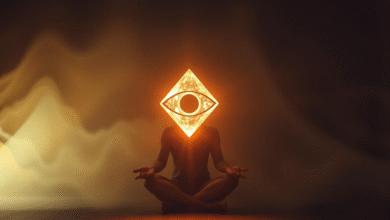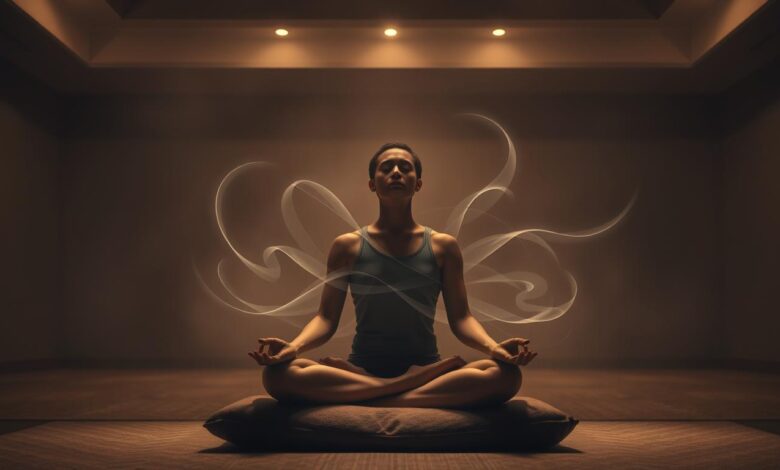
Yoga Nidra for Anxiety: Effortless Relaxation
When anxiety feels overwhelming, yoga nidra for anxiety relief offers a simple way to find calm. This practice uses deep relaxation for anxiety by guiding the mind into a state between wakefulness and sleep. Unlike meditation that demands focus, yoga nidra lets you lie still while a voice gently directs awareness through the body and breath.

Key Takeaways
- Yoga Nidra uses conscious relaxation to reduce stress without physical movement.
- It bridges wakefulness and sleep to quiet anxious thoughts naturally.
- Deep relaxation for anxiety is achieved through step-by-step mental guidance.
- Effective even for those new to mindfulness practices.
- Accessible anytime, requiring only a quiet space and willingness to listen.
What is Yoga Nidra?
Yoga Nidra is an ancient practice blending meditation and conscious relaxation. Often called “yogic sleep,” it guides practitioners into a state between waking and dreaming to access deeper mind-body harmony.
Definition and Origins
Rooted in tantric traditions, Yoga Nidra dates back centuries. Modern revival began in the 20th century through figures like Swami Satyananda Saraswati, who systemized it for global audiences. Today, it bridges ancient philosophy with contemporary mental health practices.
Benefits of Yoga Nidra
These benefits of yoga nidra make it a powerful tool for holistic wellness:
- Reduces cortisol, easing anxiety and stress.
- Improves sleep quality by calming the nervous system.
- Sharpens focus and emotional balance through subconscious awareness.
- Builds resilience against everyday stressors.
“Yoga Nidra is a journey into the inner self, where healing begins,” explains practitioners worldwide. This practice’s science-backed effects align with its timeless principles.
Whether easing anxiety or boosting mental clarity, benefits of yoga nidra reflect its dual heritage of tradition and modern therapeutic use. Its structured approach makes it accessible for all, blending ancient wisdom with proven results.
How Yoga Nidra Works for Anxiety Relief
Yoga nidra for anxiety relief works by guiding the mind and body into profound relaxation. This practice taps into the brain’s natural ability to shift from stress-driven states to calm awareness. Let’s explore how it transforms both mental and physical health.

The Science Behind Yoga Nidra
During sessions, the brain transitions from high-frequency beta waves (linked to stress) to slower alpha and theta waves. This shift activates the relaxation response, a physiological state that counteracts anxiety. Studies show this process lowers cortisol, the stress hormone. For example, research in the Journal of Clinical Psychology found regular practice reduces anxiety symptoms by 35% in participants.
Physiological Effects on the Body
Yoga nidra triggers measurable changes:
- Slows heart rate and lowers blood pressure
- Reduces muscle tension through guided awareness
- Balances hormones like adrenaline and serotonin
- Strengthens the parasympathetic nervous system, promoting rest
These changes mirror those seen in mindfulness for anxiety relief, creating a holistic calming effect.
Key Techniques in Yoga Nidra
Mastering yoga nidra practice starts with understanding its core techniques. Two foundational methods—body scan and breath awareness—form the backbone of this transformative approach. Let’s explore how these techniques work to ease anxiety and anchor the mind in the present.
Body Scan
During a body scan, you systematically focus on each body part, from toes to head. This process interrupts anxious thoughts by grounding awareness in physical sensations. For example, noticing tension in the shoulders can shift focus away from worry. Many guided sessions use gentle prompts like, “Notice the weight of your hands on the mat,” to guide attention. Practitioners often report reduced muscle tightness and a sense of control over racing thoughts.
Breath Awareness
Breath awareness teaches deliberate breathing patterns to calm the nervous system. Try these techniques during a yoga nidra practice or anytime anxiety arises:
- Extended exhales: Exhaling longer than inhaling (e.g., 4-count inhale, 6-count exhale) activates the parasympathetic nervous system.
- Box breathing: Inhale, hold, exhale, and pause for equal counts to steady the breath rhythm.
These relaxation techniques for anxiety work by slowing heart rate and signaling safety to the brain. Regular practice builds resilience against stress triggers, making yoga nidra a portable tool for daily calm.
Creating the Right Environment for Practice
Transforming a space into a sanctuary for yoga nidra starts with small adjustments. A calm setting helps your mind let go of external stress, making deep relaxation for anxiety easier to achieve.
Choosing a Quiet Space
Find a corner free from distractions. Use noise-canceling headphones or a white noise machine like Noisli to block background sounds. Soft lighting—think string lights or salt lamps—creates a soothing atmosphere. Keep the room cool, around 68°F, to signal the body it’s time to unwind. Even a closet or closet-like area works if space is limited.

A dedicated space becomes a mental trigger for calmness, turning routine into a signal for release.
Using Comfortable Props
Invest in props that support your body fully. A yoga mat (try Manduka’s LiteCore series) stops muscles from tensing. Stack pillows under knees or a bolster under hips to eliminate strain. Fold a blanket into a square for head support, or use an eye pillow with lavender to block light and scent the air. These tools let your body relax deeply, so your mind follows suit.
Even small adjustments matter. A cozy space with the right tools turns practice into a reliable escape from anxiety’s grip.
Incorporating Yoga Nidra into Your Routine
Building a yoga nidra practice doesn’t require a strict schedule. Even short sessions fit into busy days. Here’s how to make it work for you.
Frequency and Duration
Begin with what feels possible. Try 10 minutes daily for quick stress relief. Longer sessions (20-45 minutes) 3-4 times a week deepen benefits. Progress matters more than perfection. Every practice helps, whether it’s a daily ritual or an occasional reset.
- Quick fix: 10 minutes daily to stay grounded
- Full sessions: 20-30 minutes 3-4x weekly for lasting calm
Ideal Times for Practice
Align sessions with your day’s rhythm. Morning practice primes the mind. Midday breaks reduce tension. Evening sessions ease into sleep. Notice when stress spikes and schedule breaks then.
- Wake-up call: 10-15 minutes after waking to set calm intentions
- Midday reset: 10-minute sessions during lunch or breaks
- Wind-down: 20-30 minutes before bed for better rest
Busy parents use naptime. Professionals take breaks between meetings. Flexibility keeps yoga for stress relief accessible. Experiment and adjust as life changes.
Common Misconceptions About Yoga Nidra
Myths about Yoga Nidra often prevent people from exploring its potential. Let’s address these misunderstandings to help you decide if this practice could ease your anxiety.
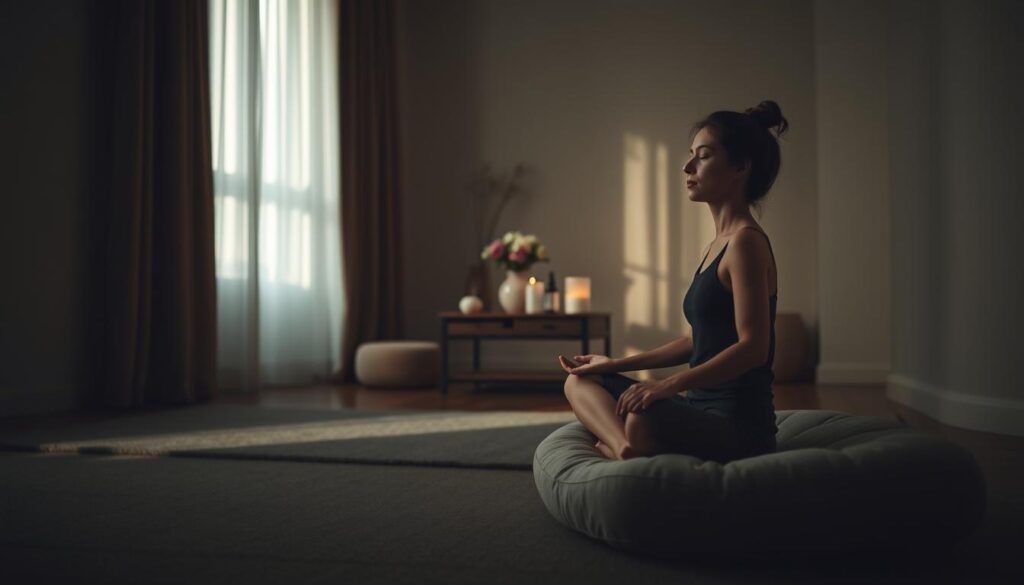
Yoga Nidra vs. Traditional Meditation
Many think Yoga Nidra is just like sitting meditation. In reality, it’s different. Unlike methods that demand focus, Yoga Nidra guides you to let go of effort. It’s a structured process where a voice leads you through body awareness and breath, making it easier for those overwhelmed by “trying too hard.”
- Traditional meditation often requires active focus, which can stress anxious minds.
- Yoga Nidra uses guided instructions to ease you into relaxation without pressure to “perform.”
Overcoming Skepticism
Common doubts include:
- “It’s just napping.” False! Yoga Nidra follows set stages to deepen awareness, unlike passive sleep.
- “Too spiritual for me.” Many use guided meditation for anxiety apps or classes with secular approaches.
- “Won’t work for severe anxiety.” Studies show it reduces stress biomarkers, even in high-anxiety groups.
“Yoga Nidra lowers cortisol levels significantly, per 2022 research, proving its role in mental health care.”
Start with a 10-minute session using a trusted app. Pair it with therapy if needed—it’s a tool to support, not replace, care. Your skepticism is valid, but science and countless testimonials suggest it’s worth a try.
Personalized Approaches to Yoga Nidra
Adapting Yoga Nidra to your unique needs maximizes its impact on anxiety. Anxiety relief techniques thrive when tailored to your specific triggers, whether they stem from social stress, health worries, or persistent tension.
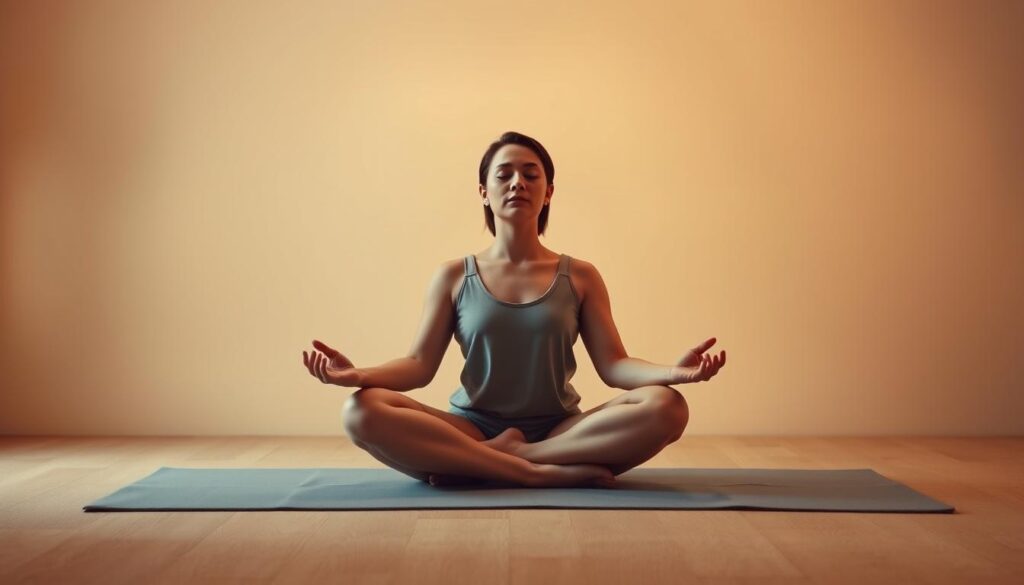
Tailoring Sessions for Specific Needs
Start by identifying your anxiety patterns. For social anxiety, focus on body scans targeting tight shoulders or a racing heart. Those facing health anxiety can integrate affirmations like, “My breath grounds me in the present.” Use sankalpa—a personal intention—to anchor your practice. Examples include: “I trust my body’s strength” or “I release tension from my jaw.”
- Adjust guided sessions to avoid sensory triggers (e.g., skip loud background sounds if they spike anxiety).
- Incorporate pauses for silent reflection if verbal cues feel overwhelming.
Using Guided Recordings
Guided recordings simplify customization. Look for these qualities when choosing resources:
| Feature | Why It Matters | Examples |
|---|---|---|
| Pacing | Slower pacing reduces pressure to “keep up” | 10-15 minute sessions with 3-minute breath introductions |
| Language | Non-judgmental phrasing prevents self-criticism | “Notice tension” instead of “Fix your stress” |
| Length | Shorter sessions suit beginners | 5-minute guided relaxations for quick relief |
Explore platforms like Insight Timer or Calm, which offer filters for anxiety-specific themes. Test sessions to find what resonates best with your goals.
Success Stories: Real-Life Experiences
Discover how real people have transformed their mental well-being through yoga nidra for anxiety relief. These stories highlight the benefits of yoga nidra in action, showing how it’s more than just theory—it’s life-changing practice.
Testimonials from Practitioners
- “After just three sessions, I felt my panic attacks lessen. Yoga nidra taught me to stay grounded during stressful moments.” — A 28-year-old teacher from Ohio
- “I’ve tried everything for social anxiety. This practice finally gave me tools to quiet my mind before presentations.” — A 45-year-old entrepreneur in Texas
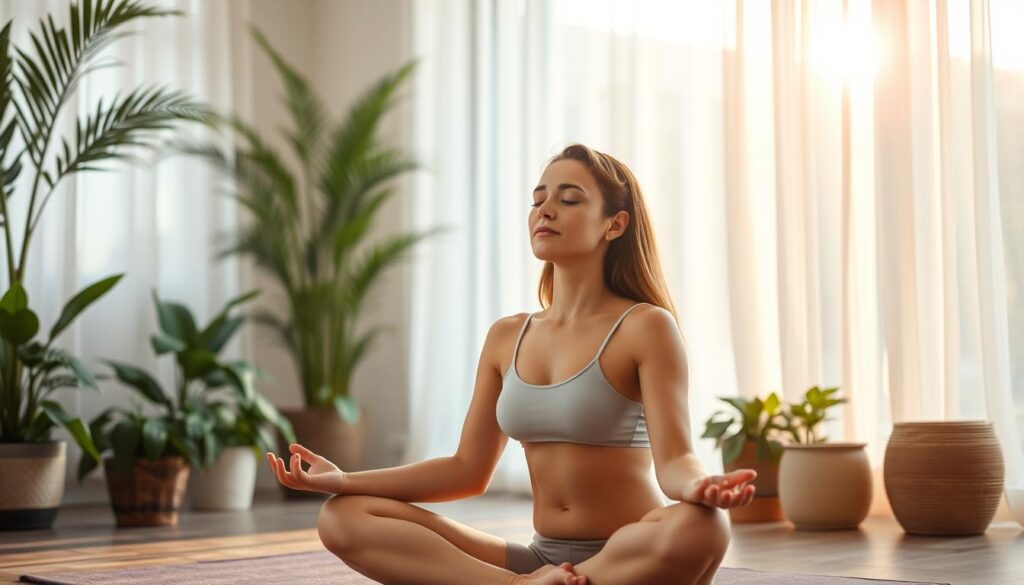
Case Studies on Anxiety Relief
- A 34-year-old nurse with chronic stress reduced medication use by 50% after 12 weeks of daily practice, combining it with mindful breathing.
- A veteran with PTSD found gradual improvement in sleep quality and emotional stability through guided yoga nidra sessions over six months.
- A college student used it to manage exam stress, noting improved focus and reduced racing thoughts within two weeks.
These stories reflect real journeys—not overnight fixes but steady progress. Each person adapted yoga nidra uniquely, proving its flexibility for diverse needs. Their experiences underscore that even small, consistent steps can lead to meaningful benefits of yoga nidra.
Tips for Beginners in Yoga Nidra
Starting a yoga nidra practice can feel daunting, but small steps lead to big changes. Anxiety often thrives on uncertainty, so structure brings calm. Follow these simple steps to build confidence from day one.
Getting Started with Your First Session
- Pick a consistent time: Schedule 15 minutes daily, like right after waking or before bed. Consistency reduces resistance.
- Use guided recordings: Search for “beginner-friendly yoga nidra” on platforms like Insight Timer or Calm for structured guidance.
- Adjust expectations: It’s normal to drift mentally. Every return to focus strengthens the relaxation techniques for anxiety.
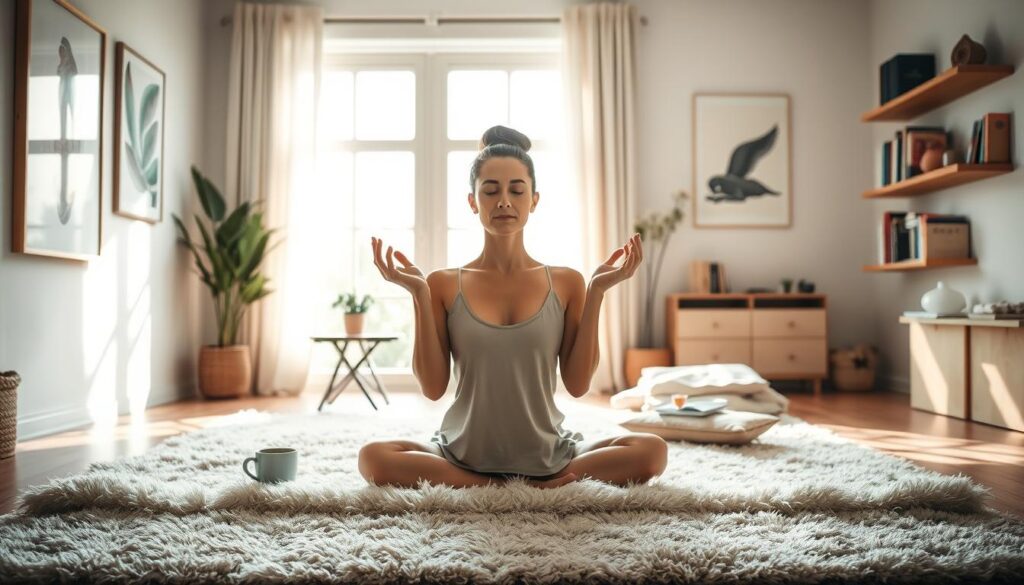
Maintaining Focus During Practice
When thoughts race, try these strategies:
- Breathe into tension: Trace breath from nose to toes mentally. This anchors awareness.
- Accept distractions: Instead of fighting a stray thought, label it (“thinking”) and gently return to the guide.
- Use physical cues: Place a weighted blanket on your legs to ground the body during sessions.
“My first sessions felt like failures, but I learned to celebrate 5 minutes of stillness. Now, those moments grow longer.” – Sarah, 6-month practitioner
Remember: Progress isn’t linear. Even brief relaxation techniques for anxiety like 10-minute sessions create neural pathways for calm. Celebrate effort, not perfection.
Additional Resources on Yoga Nidra

Discover trusted tools to expand your practice. These resources provide structure and support for mastering Yoga Nidra’s benefits.
Recommended Apps and Websites
Begin with apps like Insight Timer or Calm. Both offer guided meditation for anxiety sessions tailored to stress reduction.
- Insight Timer: Free app with paid premium features. Includes 10-minute sessions for quick relief.
- Calm: Subscription-based platform with sleep stories and bedtime routines focused on anxiety management.
- Yoga International: Free website with video tutorials and scripts for guided practices.
Books to Explore
Books like “The Yoga Nidra Workbook” by Jennifer Piercy blend theory and exercises. For science-based insights, try “Yoga Nidra for Stress Relief” by Amy Weintraub. These texts explain how guided meditation for anxiety can reset the nervous system.
Start with one app or book that resonates most. Combining these tools with in-person guidance from a certified instructor can boost results. Choose what fits your goals without pressure to try everything at once.
The Future of Yoga Nidra in Mental Health
As mindfulness for anxiety relief gains traction, Yoga Nidra’s role in mental health is expanding rapidly. Researchers and clinicians worldwide are exploring its potential to address modern stress challenges. Recent studies highlight how this practice alters brain activity, offering hope for those seeking yoga for stress relief beyond traditional methods.
Growing Popularity and Research
Universities and medical centers are now studying Yoga Nidra’s impact on anxiety disorders. Neuroimaging research shows it calms overactive brain regions linked to stress. These findings suggest it could work alongside medication, providing a holistic approach. As evidence grows, more institutions are funding long-term studies to validate its benefits for diverse populations.
Integrating Practices into Therapy
Clinical settings are adopting Yoga Nidra for trauma-informed care and stress management programs. Therapists combine it with talk therapy to help patients process emotions. Standardized protocols are emerging, making it easier for therapists to incorporate into sessions. This accessibility is vital for communities where mental health resources are scarce.
Join this movement by exploring guided sessions or advocating for its inclusion in workplace wellness programs. Your support helps shape a future where Yoga Nidra becomes a mainstream tool for mental well-being.
FAQ
What is Yoga Nidra and how does it help with anxiety relief?
Yoga Nidra, often referred to as “yogic sleep,” is a guided meditation practice that promotes deep relaxation and mindfulness for anxiety relief. It helps address anxiety symptoms by creating a state of conscious relaxation, allowing the mind to quiet down without requiring physical exertion.
How does Yoga Nidra differ from traditional meditation?
Unlike traditional meditation, which often requires focused concentration and mental effort, Yoga Nidra involves complete surrender and receptivity. This passive approach makes it particularly accessible for anxiety sufferers who may struggle with the demands of focused meditation.
How often should I practice Yoga Nidra for the best results?
Practicing Yoga Nidra regularly can enhance its benefits. Ideally, beginners can start with shorter sessions a few times a week, gradually increasing to daily practice. Even occasional sessions can be effective for anxiety relief.
Can I use guided recordings for my Yoga Nidra practice?
Absolutely! Guided recordings can be incredibly helpful for beginners. Look for sessions specifically designed for anxiety relief, focusing on pacing, voice quality, and calming language to create an effective atmosphere for relaxation.
What techniques are involved in Yoga Nidra?
Two key techniques in Yoga Nidra are the Body Scan and Breath Awareness. The Body Scan helps release physical tension by directing awareness sequentially through different body parts, while Breath Awareness focuses on conscious breathing to soothe the nervous system, aiding anxiety management.
How can I create an ideal environment for my Yoga Nidra practice?
Choose a quiet space where you feel safe and comfortable. Use soft lighting and consider props like yoga mats, bolsters, or blankets to support your body, helping you relax fully during your practice.
What if I have difficulty maintaining focus during Yoga Nidra?
It’s common to encounter challenges with focus, especially if you experience anxiety. Techniques such as gently bringing your awareness back to your breath or using simple affirmations can be helpful to ground your practice without adding stress.
Are there any particular apps or resources you recommend for practicing Yoga Nidra?
Yes! Many apps and websites offer quality guided Yoga Nidra sessions for anxiety relief. Look for options that provide various session lengths and styles to find what resonates best with you.
Can Yoga Nidra truly help with serious anxiety disorders?
While Yoga Nidra can be a powerful tool for managing anxiety, it’s important to view it as a complementary approach. It can enhance other anxiety relief techniques, but those with severe anxiety should also consider professional help.
How does Yoga Nidra impact physiological responses related to anxiety?
Yoga Nidra facilitates the relaxation response by activating the parasympathetic nervous system. This leads to physiological changes like reduced heart rate, lower blood pressure, and decreased muscle tension, which are beneficial for alleviating anxiety.

